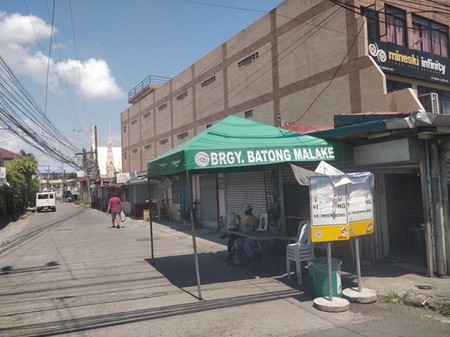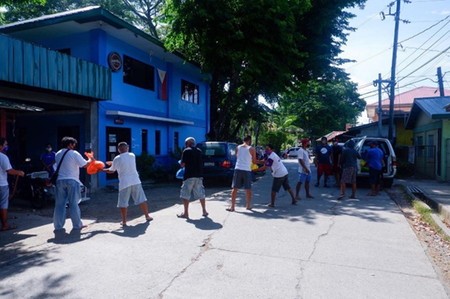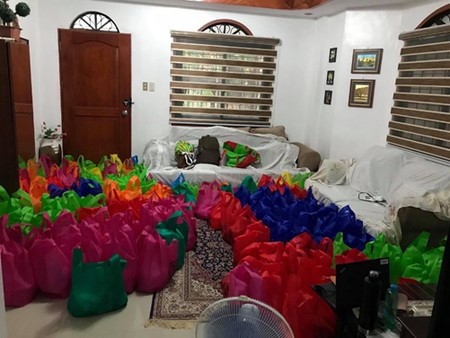【20-30】フィリピンにおける新型コロナウイルスの状況
2020年6月16日 Cris Nino Bon Marasignan(University of Philippines, Los Baños、さくらサイエンスプラン同窓生)
科学技術振興機構(JST)中国総合研究・さくらサイエンスセンター(CRSC)では、2014年度より日本・アジア青少年サイエンス交流事業「さくらサイエンスプラン(SSP)」を実施し、科学技術交流を通じてわが国とアジアを中心とした各国・地域との連携・協力関係を深めてまいりました。各種報道の通り、現在、世界中で新型コロナウイルス感染症の流行が拡大しておりますが、本コーナーでは「さくらサイエンスプラン」に参加している各国・地域の関係機関・関係者より現地の新型コロナウイルス感染症について、その状況や対策等をリポートします。
[背景]
フィリピンで確認された新型コロナウイルス感染の最初の症例は、2020年1月30日に報告されたもので、中国・武漢出身の中国人が軽度の咳のためにマニラのサン・ラザロ病院に入院したときのことです。数日後、彼女の男性の友人も新型コロナウイルスの検査で陽性であることがわかりましたが、他の病気との合併症で死亡しました。これが中国以外での最初の中国人の死亡となりました。2月5日にフィリピンのボホールで再び中国人女性が感染するという3番目のケースが確認されました。これらの3人の患者全員がフィリピンに来る前に香港からの旅行履歴があることが分かりました。その後、しばらくは新規の感染症例は確認されませんでしたが、それからわずか1ヵ月後に、日本から帰国した患者が入院し、感染が確認されました。それに続く5番目の感染者は国外への旅行歴がない人で、これが国内発症の最初の症例となりました。

かつては賑わっていた通りも、現在は人通りもなく、立て看板のみの案内となっています
5月13日の時点で、フィリピンでは合計で11,350人の感染者が確認されており、751人の患者が感染により死亡しましたが、2,106人が既に回復しています。(出典:doh.gov.ph/covid19tracker )保健省のデータによると、フィリピンでは既に合計158,384回の検査が実施されており、熱帯医学研究所がこの疾患の疑いのある症例の検査をリードしています。 現在、検査センターの数は25箇所に増えています。

支援物資の運搬のためソーシャルディスタンスを守って作業します
マスクの常時着用もまだ求められています
[対応]
国内で確認された感染の増加を受け、いくつかの対策が実施されました。3月16日以降、ルソン島全体が「コミュニティ検疫」(ECQ)の下に置かれ、公共交通機関の一時停止、全世帯における厳しい自宅隔離の実施、全ての民間施設の閉鎖などが課されます。医療従事者やその他の「最前線」の従事者は厳格な自宅隔離から免除されていました。ECQは当初4月30日に解除される予定でしたが、5月15日まで延長されました。
大災害宣言に続いて「バヤニハンで回復しよう」法(バヤニハンは「助け合い」の意)が制定されました。この法律により、大統領はパンデミックへの対応として、2,750億フィリピンペソ(約54億ドル)と見込まれる予算を再編成し、再計画することができます。受益者に1人当たり5,000~8,000フィリピンペソ(約100〜160ドル)を支給することを目的とする政府の社会改善プログラムも開始されました。
[大学や他の私企業からの支援]
様々な機関が政府の進めているパンデミックとの闘いを助けるための支援を示しています。まず、フィリピン大学の研究者と科学者達は、病原体の核酸を迅速に検出するように設計された新型コロナウイルスの迅速な検査キット(GenAmplifyTM COVID-19 rRT-PCR検査キット)を開発しました。この検査キットは海外から入手するものよりも安価であるとされています。この開発者によると2時間以内に結果が得られるとのことです。これとは別に、国中にあるフィリピン大学の別のキャンパスが支援を提供していますが、それらの支援は、医療の最前線で働く人々のために3次元でプリントされたフェイスシールドを提供すること、診断のために病院にRT-PCRの装置を貸し出すこと、入院患者のために手頃な価格の人工呼吸器を設計すること、大学の研究所を地方の検査センターとして使用することができるように提供すること、などです。さらに、フィリピン大学の COVID-19パンデミック対策チームは、Webポータルを作り、国内の新型コロナウイルス感染に関する情報を一般市民と対応者に提供することにしました。
"このウェブサイトは詳細なマップを持っており、利用者はズームイン、またはズームアウトにより道路から全体的な場所の衛星画像に至るまでの情報や、また、感染者の数、病院、検疫場所、その他のフィリピン大学の機能回復研究所(UPRI)のスタッフが入力した利用可能なデータを見ることができるようになっています。この使いやすいマップは、確認された新型コロナウイルスの感染者の濃度も示しており、各地のエリアを高いエリア(暗い色)と低いエリア(明るい色)とに分けて示しています。"(up.edu.ph/up-launches-web-portal-map-for-covid-19-responders/から引用)

自宅隔離によって深刻な影響を受けている日雇い労働者に対して大学の卒業生から寄付された多くの食料品
これを書いている時点で、我が国は依然としてこのパンデミックと戦っています。多くのフィリピン人は現在の政策、特に日々の収入を得ることについて苦労しています。地域社会での自宅隔離が強化されてきたため、多くの人々が仕事を失い、限られた食料が供給されるだけになってしまいました。毎週、地方自治体は人数が3〜5人の家庭にとって十分な食料の配給を行っています。地方自治体はまた、地域内の集会を最小限に抑えるために別な形のプログラムを行うよう指示されています。このように、多くの市町村では、人の密集を最小限に抑えるために、既に移動マーケットを実施しています。
現在、学校を含む全ての公共活動は無期限に停止されています。多くの人がまだ自宅で快適に働いている一方で、私達が従来通りの日常生活にすぐに戻ることができるかどうかは不透明です。今のところ、熱帯の国でさえも物理的な接触が少なくなるようにマスクを着用することが「新しい常識」でなければならない、という事実に向き合わなければなりません。
(2020年5月13日)
※本稿はさくらサイエンスプラン同窓生からの寄稿文を中国総合研究・さくらサイエンスセンターが日本語訳したものである。
●英文オリジナル
COVID-19 situation in the Philippines
Date written: 13 May 2020
Background. The first confirmed case of coronavirus disease (COVID-19) in the Philippines was reported on 30 January 2020, with a Chinese national from Wuhan, China being admitted to San Lazaro Hospital in Manila due to mild cough. Days later, her male companion also tested positive for COVID-19 and had succumbed to death due to mixed infection - first death outside China. A third case involving a female Chinese was recorded again on 05 February 2020 in Bohol, Philippines. All three patients were found to have travel history from Hong Kong before coming to the Philippines. No new cases were recorded after that. However, it was only a month after, that another patient who had returned from Japan was admitted and confirmed to have contracted the disease. This was followed by a fifth patient without any travel history outside of the country; hence, the first local transmission of the infection in the Philippines.
As of 13 May 2020, there are a total of 11,350 confirmed cases of COVID-19 infection in the Philippines, 751 patients have already died from the infection while 2106 individuals have already recovered (source:doh.gov.ph/covid19tracker). According the data from the Department of Health (DOH), a total of 158,384 tests have already conducted in the country, with the Research Institute for Tropical Medicine (RITM) spearheading the testing of suspected cases of the disease. Currently, the number of testing centers have increased to twenty-five.
Response. Several measures were implemented following the increasing number of confirmed COVID-19 cases in the country. Since 16 March 2020, the entire Luzon has been placed under 'enhanced community quarantine' (ECQ) which entails suspension of mass public transportation, imposition of strict home quarantine among all households, closure of all private establishments, among others. It is noteworthy that healthcare workers and other 'frontliners' are exempted from the strict home quarantine. The ECQ was expected to be lifted on 30 April 2020, but it was extended to until 15 May 2020.
Following the declaration of state of calamity, the 'Bayanihan to Heal as One' Act ('bayanihan' means 'communal work') was enacted. The act allows the President to realign and reprogram an estimated budget of PHP 275 billion (approximately $5.4 billion) in response to the pandemic. The Social Amelioration Program (SAP) of the government, which aims to distribute PHP 5,000 to PHP 8,000 (approx. $100-$160) to beneficiaries, has also commenced.
Support from universities and other private firms. Various institutions have shown their support to help the government in combatting the on-going pandemic. For one, researchers and scientists from the University of the Philippines (UP) have developed a rapid test kit for COVID-19 (GenAmplifyTM COVID-19 rRT-PCR Detection Kit) that is designed to rapidly detect the nucleic acid of the pathogen. The test kit is said to be cheaper than those available from abroad. The developer also claims that it can provide results in two hours. Aside from this, different UP campuses across the country have offered help by providing 3D-printed face shields for 'frontliners'; by lending RT-PCR machines to hospitals for diagnosis; by designing affordable ventilators for admitted patients; and, by offering their laboratories to be used as subnational testing centers. Moreover, the UP COVID-19 Pandemic Response Team made a web portal that provides information to the public and responders about the COVID-19 situation in the country:
"The website features a highly detailed map wherein users can zoom in or zoom out to see street or satellite views of the general locations and numbers of COVID-19 cases, hospitals, quarantine checkpoints, and other usable data inputted by UP Resilience Institute (UPRI) staff. The easy-to-use map also has a color-coded "heat map" showing which localized areas have the most (darker areas) and the least (brighter areas) number of confirmed COVID-19 cases." (Lifted fromup.edu.ph/up-launches-web-portal-map-for-covid-19-responders/)
As of this writing, our country is still battling the wrath of this pandemic. Many Filipinos are having difficult time to cope with the current policies, especially the daily earners. With the community quarantine being enhanced, many of us have lost their jobs and only left with limited supply of foods. Weekly, the local government units (LGU) are distributing food ration enough to feed a family with 3-5 members. LGUs are also directed to conduct different programs to minimize congregation of people within an area. As such, many cities and towns have already implemented the mobilization of markets ("mobile palengke") in the hopes that mass gathering will be minimized.
Currently, all public activities, including schools, have been suspended indefinitely. While many are still working in the comforts of their homes, it is still uncertain if we will still be able to go back to our old routine anytime soon. For now, we must face the fact that, even in a tropical country, wearing facemasks with less physical contact should be the 'new normal'.
Contributed by Cris Nino Bon Marasignan,
University of Philippines, Los Baños,